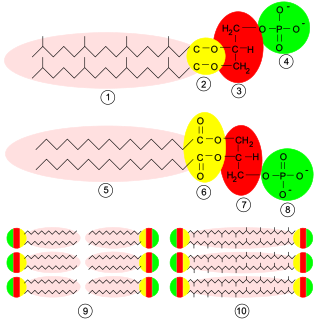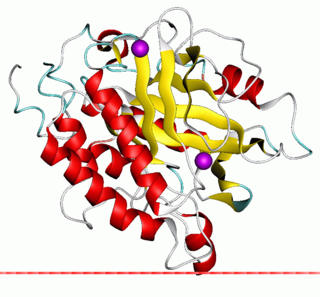Phosphatidic acids are anionic phospholipids important to cell signaling and direct activation of lipid-gated ion channels. Hydrolysis of phosphatidic acid gives rise to one molecule each of glycerol and phosphoric acid and two molecules of fatty acids. They constitute about 0.25% of phospholipids in the bilayer.

Glycerophospholipids or phosphoglycerides are glycerol-based phospholipids. They are the main component of biological membranes. Two major classes are known: those for bacteria and eukaryotes and a separate family for archaea.

Glycerophospholipids of biochemical relevance are divided into three subclasses based on the substitution present at the sn-1 position of the glycerol backbone: acyl, alkyl and alkenyl. Of these, the alkyl and alkenyl moiety in each case form an ether bond, which makes for two types of ether phospholipids, plasmanyl, and plasmenyl. Plasmalogens are plasmenyls with an ester linked lipid at the sn-2 position of the glycerol backbone, chemically designated 1-0(1Z-alkenyl)-2-acyl-glycerophospholipids. The lipid attached to the vinyl ether at sn-1 can be C16:0, C18:0, or C18:1, and the lipid attached to the acyl group at sn-2 can be C22:6 ω-3 or C20:4 ω-6, . Plasmalogens are classified according to their head group, mainly as PC plasmalogens (plasmenylcholines) and PE plasmalogens (plasmenylethalomines) Plasmalogens should not be confused with plasmanyls.
sn-Glycerol 3-phosphate is the organic ion with the formula HOCH2CH(OH)CH2OPO32-. It is one of three stereoisomers of the ester of dibasic phosphoric acid (HOPO32-) and glycerol. It is a component of glycerophospholipids. From a historical reason, it is also known as L-glycerol 3-phosphate, D-glycerol 1-phosphate, L-α-glycerophosphoric acid.

In enzymology, a glycerol-3-phosphate dehydrogenase (NAD+) (EC 1.1.1.8) is an enzyme that catalyzes the chemical reaction
Alkylglycerol monooxygenase (AGMO) is an enzyme that catalyzes the hydroxylation of alkylglycerols, a specific subclass of ether lipids. This enzyme was first described in 1964 as a pteridine-dependent ether lipid cleaving enzyme. In 2010 finally, the gene coding for alkylglycerol monooxygenase was discovered as transmembrane protein 195 (TMEM195) on chromosome 7. In analogy to the enzymes phenylalanine hydroxylase, tyrosine hydroxylase, tryptophan hydroxylase and nitric oxide synthase, alkylglycerol monooxygenase critically depends on the cofactor tetrahydrobiopterin and iron.
In enzymology, a glycerol-3-phosphate oxidase (EC 1.1.3.21) is an enzyme that catalyzes the chemical reaction

The enzyme phosphatidylinositol diacylglycerol-lyase catalyzes the following reaction:
In enzymology, a 1-acylglycerophosphocholine O-acyltransferase is an enzyme that catalyzes the chemical reaction
In enzymology, a 2-acylglycerol-3-phosphate O-acyltransferase is an enzyme that catalyzes the chemical reaction
In enzymology, an acyl-[acyl-carrier-protein]-phospholipid O-acyltransferase is an enzyme that catalyzes the chemical reaction
Decylcitrate synthase (EC 2.3.3.2) is an enzyme that catalyzes the chemical reaction in enzymology.
In enzymology, a diacylglycerol-sterol O-acyltransferase is an enzyme that catalyzes the chemical reaction
In enzymology, a glycerol-3-phosphate O-acyltransferase is an enzyme that catalyzes the chemical reaction
In enzymology, a phospholipid:diacylglycerol acyltransferase is an enzyme that catalyzes the chemical reaction
In enzymology, a galactolipid galactosyltransferase is an enzyme that catalyzes the chemical reaction
In enzymology, a monogalactosyldiacylglycerol synthase is an enzyme that catalyzes the chemical reaction

In enzymology, a CDP-diacylglycerol—inositol 3-phosphatidyltransferase is an enzyme that catalyzes the chemical reaction
In enzymology, a CDP-diacylglycerol—serine O-phosphatidyltransferase is an enzyme that catalyzes the chemical reaction

2-acyl-sn-glycero-3-phosphocholines are a class of phospholipids that are intermediates in the metabolism of lipids. Because they result from the hydrolysis of an acyl group from the sn-1 position of phosphatidylcholine, they are also called 1-lysophosphatidylcholine. The synthesis of phosphatidylcholines with specific fatty acids occurs through the synthesis of 1-lysoPC. The formation of various other lipids generates 1-lysoPC as a by-product.






